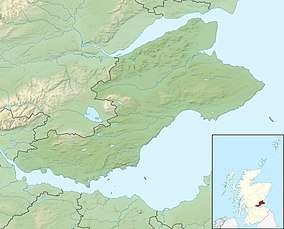Old Course at St Andrews
The Old Course at St Andrews is considered the oldest golf course in the world[2][3] and commonly known as 'The Home of Golf'. It is a public course over common land in St Andrews, Fife, Scotland and is held in trust by The St Andrews Links Trust under an act of Parliament. The Royal and Ancient Golf Club of St Andrews club house sits adjacent to the first tee, although it is but one of many clubs (St Andrews Golf Club, New Golf Club, St Regulus Golf Club and St Rules Golf Club are the others) that have playing privileges on the course, along with the general public.
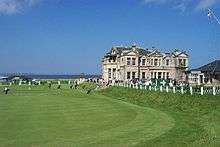 R&A Clubhouse and 18th green in August 2004 | |
| Club information | |
|---|---|
| Coordinates | 56.343°N 2.803°W |
| Location | St Andrews, Scotland |
| Established | 1552 |
| Type | Public |
| Owned by | Fife Council[1] |
| Operated by | St Andrews Links Trust |
| Total holes | 18 |
| Tournaments hosted | The Open Championship, Alfred Dunhill Links Championship |
| Website | Old Course |
| Par | 72 |
| Length | 7,305 yards (6,680 m) |
| Course record | 61; Ross Fisher (2017) |
History
The Old Course at St Andrews is considered by many to be the "home of golf" because the sport was first played on the Links at St Andrews in the early 15th century.[4] Golf was becoming increasingly popular in Scotland until James II of Scotland banned the game in 1457 because he felt that young men were playing too much golf instead of practising their archery.[4] The ban was upheld by James III, and remained in force until 1502, when James IV became a golfer himself and removed the ban.[5]
Governance
In 1552, Archbishop John Hamilton gave the townspeople of St Andrews the right to play on the links. In 1754, 22 noblemen, professors, and landowners founded the Society of St Andrews Golfers. This society would eventually become the precursor to the Royal and Ancient which is the governing body for golf everywhere outside of the United States and Mexico.[6] St Andrews Links had a scare when they went bankrupt in 1797.[6] The Town Council of St Andrews decided to allow rabbit farming on the golf course to challenge golf for popularity. Twenty years of legal battling between the golfers and rabbit farmers ended in 1821 when a local landowner and golfer named James Cheape of Strathtyrum bought the land and is credited with saving the links for golf.[4] The course evolved without the help of any one architect for many years, though notable contributions to its design were made by Daw Anderson in the 1850s and Old Tom Morris (1865–1908), who designed the 1st and 18th holes. Originally, it was played over the same set of fairways out and back to the same holes. As interest in the game increased, groups of golfers would often be playing the same hole, but going in different directions.[4]
Influence on modern golf
The Old Course was pivotal to the development of how the game is played today. For instance, in 1764, the course had 22 holes and the members would play the same hole going out and in with the exception of the 11th and 22nd holes. William St Clair of Rosslyn as the captain of The Captain and Gentlemen Golfers authorized changes to St Andrews on 4 October 1764.[7] He decided that the first four and last four holes on the course were too short and should be combined into four total holes (two in and two out). St Andrews then had 18 holes and that was how the standard of 18 holes was created.[8] Around 1863, Old Tom Morris had the 1st green separated from the 17th green, producing the current 18-hole layout with 7 double greens and 4 single greens. The Old Course is home of The Open Championship, the oldest of golf's major championships. The Old Course has hosted this major 29 times since 1873, most recently in 2015. The 29 Open Championships that the Old Course has hosted is more than any other course, and The Open is currently played there every five years.
Old Course and Bobby Jones
Bobby Jones (who later founded Augusta National) first played St Andrews in the 1921 Open Championship. During the third round, he infamously hit his ball into a bunker on the 11th hole. After he took four swings at the ball and still could not get out, he lost his temper and continued the round, but did not turn in his score card, disqualifying himself. However, he did continue to play in the fourth round. Six years later, when the Open Championship returned to St Andrews, Jones also returned. Not only did he win, he also became the first amateur to win back-to-back Open Championships. He won wire-to-wire, shooting a 285 (7-under-par), which was the lowest score at either a U.S. Open or Open Championship at the time. He ended up winning the tournament by a decisive six strokes.
In 1930, Jones returned to St Andrews for the British Amateur.[9] He won, beating Roger Wethered by a score of 7 and 6 in the final match. He subsequently won the other three majors, making him the only man in the history of the sport to win the Grand Slam. Jones went on to fall in love with the Old Course for the rest of his life. Years later, he said "If I had to select one course upon which to play the match of my life, I should have selected the Old Course." In 1958 the town of St Andrews gave Jones the key to the city; he was only the second American to receive the honour (after Benjamin Franklin in 1759). After he received the key, he said "I could take out of my life everything but my experiences here in St Andrews and I would still have had a rich and full life."[10]
Features
—Jack Nicklaus on finishing his career at St Andrews, 2005.[11]

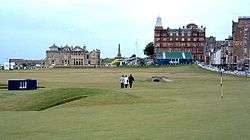
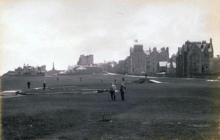
One of the unique features of the Old Course are the large double greens. Seven greens are shared by two holes each, with hole numbers adding up to 18 (2nd paired with 16th, 3rd with 15th, all the way up to 8th and 10th). The Swilcan Bridge, spanning the first and 18th holes, has become a famous icon for golf in the world.[12] Everyone who plays the 18th hole walks over this 700-year-old bridge, and many iconic pictures of the farewells of the most iconic golfers in history have been taken on this bridge.[13] A life-size stone replica of the Bridge is situated at the World Golf Hall of Fame museum in St. Augustine, Florida.[13] Only the 1st, 9th, 17th and 18th holes have their own greens. Another unique feature is that the course can be played in either direction, clockwise or anti-clockwise. Along with that, the Old Course has 112 bunkers which are all individually named and have their own unique story and history behind them. The two most famous are the 10 ft deep "Hell Bunker"[14] on the 14th hole, and the "Road Bunker" on the 17th hole. Countless professional golfers have seen their dreams of winning the Open Championship squandered by hitting their balls into those bunkers.
The Old Course is also home of The Road Hole, the par-4 17th, one of the world's most famous golf holes and perhaps the hardest hole in tournament golf. Among its unique features are:
- Players using the back tees cannot see where their tee shots land. This is not unusual except that they must take aim over a corner of replica railway sheds which lie beyond the out of bounds wall. The original sheds were torn down when the rail line running next to the course closed, and after several Opens were played without the tee shot being blind, replicas of the sheds were created in preparation for the 1984 Open.
- Other than rough, the primary hazard in front of the green is a sand trap known as the "Road Bunker."
- Over the back of the green, hazards include a tarmac roadway, as well as an old stone wall. Both are in play; a wayward shot can lead a player to take their next stroke off the roadway or to hit the face of the wall and take their chances with the ensuing bounce.
The general method of play today is counterclockwise, although clockwise play has been permitted on one day each year in recent years, and for several special one off events since. Originally, the course was reversed every week in order to let the grass recover better. One other unusual thing about the Old Course is that it is closed on Sundays to let the course rest.[15] On some Sundays, the course turns into a park for all the townspeople who come out to stroll, picnic and otherwise enjoy the grounds. As a general rule, Sunday play is allowed on the course on only four occasions:
- The final day of the Dunhill Links Championship, an annual event on the European Tour.
- The final day of any R&A sanctioned Open Championships – men and women, and the men over 50 when it is held at the Old Course; this happens roughly once every five years for the men; the women's championship began its turn on the rotation in 2007, and the over-50 championship began in 2018.
- The final day of two top amateur events, the St Andrews Links Trophy and the St Rule Trophy.
Sunday play may also occur when the Old Course hosts other major events; for example, when it hosted the Curtis Cup in 2008.
The Open Championship
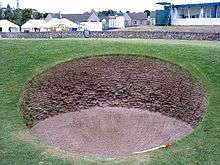
The Open Championship has been staged at the Old Course at St Andrews 29 times. The following is a list of the champions:
| Year | Winner | Score | Notes | ||||
|---|---|---|---|---|---|---|---|
| R1 | R2 | R3 | R4 | Total | |||
| 1873 | 91 | 88 | – | – | 179 | This was the first time the Open Championship was played on an 18-hole course. Instead of three rounds of 12 holes, there were two rounds of 18. Kidd won £11. | |
| 1876 | 86 | 90 | – | – | 176 | Due to a controversial ruling, Bob Martin finished in a tie for first. In protest, his opponent Davie Strath refused to participate so Martin walked the course and became the Open Champion. He won £10. | |
| 1879 | 84 | 85 | – | – | 169 | With this win, Jamie Anderson became the first person to break 170 in the Open Championship. He won £10. | |
| 1882 | 83 | 88 | – | – | 171 | This was the third straight Open Championship for Ferguson. He won £12. | |
| 1885 | 84 | 87 | – | – | 171 | The second of Martin's Open Championship wins, he won £10. | |
| 1888 | 86 | 85 | – | – | 171 | Burns won after his score was re-added, giving him a one-stroke victory. The winners share was £8. | |
| 1891 | 83 | 83 | – | – | 166 | Kirkaldy set the tournament record with his 166. This was also the last Open Championship that was 36 holes. The winners share was £10. | |
| 1895 | 86 | 78 | 80 | 78 | 322 | This was the first Open to be played over two days (36 holes a day) and a total of 72 holes at St Andrews. He shot the first sub-80 rounds at St Andrews. The winners share was £30. | |
| 1900 | 79 | 77 | 78 | 75 | 309 | This open marked the first time the "Great Triumvirate" finished 1-2-3. That was the name given to the three golfers who dominated the game in the late 19th century to the early 20th century. From 1894 to 1914, J.H. Taylor, Harry Vardon, and James Braid combined to win 16 Open Championships. This was Taylor's third of five Open Championships. The winners share was £50. | |
| 1905 | 81 | 78 | 78 | 81 | 318 | This was the first Open to be played over three days, with 36 holes on the last day. This was Braid's second of five Open Championships. The winners share was £50. | |
| 1910 | 76 | 73 | 74 | 76 | 299 | This Open was the last of Braid's five Open Championships. With this win he became the first person to break 300 in a four-round Open at St Andrews, and was the first to win five Open Championships. The winners share was £50. | |
| 1921 | 72 | 75 | 79 | 70 | 296 PO | Born in Scotland, Hutchison was the first American citizen to win the Open Championship with this win. This was also the first time Bobby Jones played St Andrews. He ended up walking off the course after he took four shots to get out of a bunker on the 11th hole. The winners share was £75. | |
| 1927 | 68 | 72 | 73 | 72 | 285 (−3) | This win marked Bobby Jones's first Open championship win at St Andrews, his second straight Open Championship, fourth professional major, and his 7th career major (he was a three-time winner of the U.S. Amateur). As an amateur, Jones received no prize money. Aubrey Boomer and Fred Robson finished in a tie for second, and the winners and second place share of £75 for first place and £50 for second place were combined and divided into two, so each player earned 62 pounds and 10 shillings. | |
| 1933 | 73 | 73 | 73 | 73 | 292 (+4) PO | Shute won the Open title by five strokes in a playoff against Craig Wood. Leo Diegel could have joined them but he whiffed a putt on the 72nd hole, finishing one shot off the lead. The winners share was £100. | |
| 1939 | 70 | 72 | 77 | 71 | 290 (−2) | The 1939 Open was the last Open until 1946 because of World War II. The Royal Air Force used the fairways of the Old Course as runways. Burton held the Claret Jug the longest (7 years), until the tournament resumed in 1946, also at St Andrews. The winners share was £100. | |
| 1946 | 71 | 70 | 74 | 75 | 290 (−2) | Even though Sam Snead won the first Open Championship to be played since 1939, he still lost money because of the high travel expenses; his winner's share was £150. When taking the train into St Andrews, Sam Snead is quoted for looking out of the window and saying "Say, that looks like an old abandoned golf course" about the Old Course. | |
| 1955 | 71 | 68 | 70 | 72 | 281 (−7) | This was the second of Thomson's three straight Open titles, and five overall. His winner's share was £1,000. | |
| 1957 | 69 | 72 | 68 | 70 | 279 (−9) | Between 1949 and 1957, Locke won the Open title four times. He survived a possible disqualification when he marked his ball on the 72nd green, and played his ball without replacing his ball mark. The R&A decided that because he had a three shot lead, and he didn't gain an advantage, that in the spirit of the game, he should not be disqualified. The winner's share was £1,000. | |
| 1960 | 69 | 67 | 71 | 71 | 278 (−10) | This was the 100th anniversary of the Open Championship, although due to wars it wasn't the 100th Open Championship to be played. Arnold Palmer finished second and is credited with returning the Open to the eyes of Americans. The winner's share was £1,250. | |
| 1964 | 73 | 68 | 68 | 70 | 279 (−9) | From 1962 to 1966, Lema won 12 times on tour, but this was his only major. He beat Jack Nicklaus by five strokes, and his winner's share was £1,500. Tragically, Lema and his pregnant wife were killed in a plane crash two years later. | |
| 1970 | 68 | 69 | 73 | 73 | 283 (−5)PO | Doug Sanders missed a tough two and a half-foot (0.75 m) putt on the 72nd hole, bogeyed, and ended up tied with Nicklaus. The playoff the next day came down to 18th hole and Nicklaus birdied to win; it was his second Open title and eighth overall major; the winner's share was £5,250. | |
| 1978 | 71 | 72 | 69 | 69 | 281 (−7) | Nicklaus completed the career Grand Slam (winning all four majors in your career at least once) for the third time making it his third Open Championship. The winner's share was £12,500 | |
| 1984 | 69 | 68 | 70 | 69 | 276 (−12) | The leaderboard for the final day was full of the best golfers in the world at the time. Ballesteros beat Bernhard Langer, Tom Watson, Fred Couples, Lanny Wadkins, Nick Faldo, and Greg Norman to make an epic final round at St Andrews. Ballesteros birdied the 72nd hole to win by two, and his fist pump is an iconic image to this day. His winner's share was £50,000. | |
| 1990 | 67 | 65 | 67 | 71 | 270 (−18) | Faldo set the Open championship scoring record shooting 18 under par, winning his second major of the year, his second Open Championship and his fourth overall major. The winner's share was £85,000. | |
| 1995 | 67 | 71 | 73 | 71 | 282 (−6)PO | This Open was significant because it was the first that Tiger Woods played in, and the last that Arnold Palmer played in, getting to have his farewell at St Andrews. John Daly beat Costantino Rocca in a four-hole playoff to win the Open title and £125,000. | |
| 2000 | 67 | 66 | 67 | 69 | 269 (−19) | Winning the 2000 Open was Tiger Woods's second consecutive major championship, making him the fifth golfer and the youngest to complete the career Grand Slam. Having won the 2000 U.S. Open at Pebble Beach, he went on to complete the "Tiger Slam" by winning the 2000 PGA Championship at Valhalla Golf Club and the 2001 Masters at Augusta National. Woods did not hit a single bunker the entire tournament, won by eight strokes, and set the new Open Championship scoring record with 19 under par. The winner's share was £500,000. | |
| 2005 | 66 | 67 | 71 | 70 | 274 (−14) | This was Jack Nicklaus's last Open Championship and like Arnold Palmer, he finished on the Old Course. This was also Tiger's 10th major championship and the fourth one he had won by five or more strokes, and the winner's share was £720,000. | |
| 2010 | 65 | 67 | 69 | 71 | 272 (−16) | On the 150th anniversary of the first Open Championship, Oosthuizen played consistently well, winning the Open title by shooting a 16 under par 272 and winning by seven strokes. Rory McIlroy shot a 63 in the opening round and the winner's share was £850,000. | |
| 2015 | 66 | 71 | 70 | 66 | 273 (−15)PO | In the 144th playing of the Open Championship, Zach Johnson emerged from a three-man playoff to win the tournament. Tom Watson was given a special exemption by the R & A in order that he could finish his Open career at the Old Course. The tournament finished on Monday due to the extremely high winds that arose during Saturday's round. Johnson defeated Louis Oosthuizen and Marc Leishman in a four-hole playoff. | |
| 2022 | 14–17 July | ||||||
- Note: Multiple winners of The Open Championship have superscript ordinal designating which in their respective careers.
- (a) denotes amateur
Scorecard
| Hole | Name | Yards | Par | Hole | Name | Yards | Par | |
|---|---|---|---|---|---|---|---|---|
| 1 | Burn | 376 | 4 | 10 | Bobby Jones | 386 | 4 | |
| 2 | Dyke | 453 | 4 | 11 | High (In) | 174 | 3 | |
| 3 | Cartgate (Out) | 397 | 4 | 12 | Heathery (In) | 348 | 4 | |
| 4 | Ginger Beer | 480 | 4 | 13 | Hole O'Cross (In) | 465 | 4 | |
| 5 | Hole O'Cross (Out) | 568 | 5 | 14 | Long | 618 | 5 | |
| 6 | Heathery (Out) | 412 | 4 | 15 | Cartgate (In) | 455 | 4 | |
| 7 | High (Out) | 371 | 4 | 16 | Corner of the Dyke | 423 | 4 | |
| 8 | Short | 175 | 3 | 17 | Road | 495 | 4 | |
| 9 | End | 352 | 4 | 18 | Tom Morris | 357 | 4 | |
| Out | 3,584 | 36 | In | 3,721 | 36 | |||
| Source:[3] | Total | 7,305 | 72 | |||||
| Tee | Rating/Slope | 1 | 2 | 3 | 4 | 5 | 6 | 7 | 8 | 9 | Out | 10 | 11 | 12 | 13 | 14 | 15 | 16 | 17 | 18 | In | Total |
|---|---|---|---|---|---|---|---|---|---|---|---|---|---|---|---|---|---|---|---|---|---|---|
| White | 73.1 / 132 | 376 | 411 | 370 | 419 | 514 | 374 | 359 | 166 | 347 | 3336 | 340 | 174 | 316 | 418 | 530 | 414 | 381 | 455 | 357 | 3385 | 6721 |
| Yellow | 71.4 / 129 | 355 | 395 | 337 | 411 | 514 | 360 | 349 | 154 | 289 | 3164 | 311 | 164 | 304 | 388 | 523 | 391 | 345 | 436 | 361 | 3223 | 6387 |
| Par | 4 | 4 | 4 | 4 | 5 | 4 | 4 | 3 | 4 | 36 | 4 | 3 | 4 | 4 | 5 | 4 | 4 | 4 | 4 | 36 | 72 | |
| Ladies' | 75.6 / 138 | 339 | 375 | 321 | 401 | 454 | 325 | 335 | 145 | 261 | 2956 | 296 | 150 | 304 | 377 | 487 | 369 | 325 | 426 | 342 | 3076 | 6032 |
| Par | Ladies' | 4 | 5 | 4 | 5 | 5 | 4 | 4 | 3 | 4 | 38 | 4 | 3 | 4 | 5 | 5 | 4 | 4 | 5 | 4 | 38 | 76 |
Women's British Open
Winners of the Women's British Open at the Old Course at St Andrews:
| Year | Winner | Score |
|---|---|---|
| 2007 | 287 (−5) | |
| 2013 | 280 (–8) |
Senior Open Championship
Winners of the Senior Open Championship at the Old Course at St Andrews:
| Year | Winner | Score |
|---|---|---|
| 2018 | 276 (−12) |
References
- "St Andrews Link Trust appointment". Scottish Government website. 14 January 2002. Retrieved 24 June 2014.
- "Scottish Golf History – Oldest Golf Sites". Retrieved 19 February 2013.
- "St Andrews – The Old Course". Archived from the original on 21 September 2012. Retrieved 19 February 2013.
- "The Old Course Experience – A Brief History of The Links". Retrieved 19 February 2013.
- Andrew Leibs (2004). "Sports and Games of the Renaissance". p. 69. Greenwood Publishing Group,
- "St Andrews – A Brief History of The Links". Archived from the original on 4 July 2012. Retrieved 19 February 2013.
- http://www.scottishgolfhistory.org/oldest-golf-sites/1574-st-andrews/
- Forrest L. Richardson (2002). "Routing the Golf Course: The Art & Science That Forms the Golf Journey". p. 46. John Wiley & Sons
- Kelly, Morgan (14 June 2005). "Jones' 1930 feat still stands test of time". USA Today. Retrieved 19 February 2013.
- DiMeglio, Steve (15 July 2010). "History, mythology combine at St Andrews, the home of golf". USA Today. Retrieved 19 February 2013.
- "Nicklaus set for St Andrews bow". BBC Sport. 3 July 2005.
- Hauser, Melanie (9 July 2010). "Old Course's humble Swilcan Bridge one of golf's great attractions". PGA of America.
- Ross, Helen (12 July 2010). "Swilcan Bridge replica a true World Golf Hall of Fame highlight". PGA of America.
- Prunty, Brendan (15 July 2010). "At the British Open at St Andrews, it's the bunkers (in addition to everything else) that will drive players mad". NJ.com. Retrieved 19 February 2013.
- Borden, Sam (12 June 2015). "Sundays on the Old Course at St. Andrews: No Golfers Allowed". The New York Times. Retrieved 14 June 2015.
Ground staff ask that people avoid greens and bunkers. On Sundays, locals and tourists explore the Old Course at St. Andrews as it enjoys a weekly rest.
External links
- Golf Course Histories – comparison of 1932 v 2012 course aerials (nb. 2012 aerial dates prior to November 2012 changes)
- BBC Golf on the Old Course – a review by former European Tour player Ken Brown and several supporting features.
- St Andrews Links Trust
- The Old Course Hotel, Golf Resort & Spa
- Royal and Ancient Golf Club of St Andrews
- St Andrews Open
- Golf Club Atlas Guide
- St Andrews Golf Development Group – info on Old Course and online booking for other St Andrews courses
- 3D Course Planner at ProVisualizer

